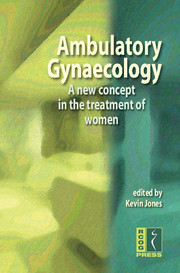Book contents
- Frontmatter
- Contents
- ABOUT THE AUTHORS
- ABBREVIATIONS
- PREFACE
- Chapter 1 Introduction
- Chapter 2 Anaesthesia and analgesia for outpatient gynaecology
- Chapter 3 Colposcopy services
- Chapter 4 Abnormal uterine bleeding
- Chapter 5 Endometrial ablation
- Chapter 6 Urogynaecology: urinary incontinence and genital prolapse
- Chapter 7 Infertility
- Chapter 8 Early pregnancy units and emergency gynaecological services
- Chapter 9 Pelvic utrasound and interventional radiology
- Index
Chapter 2 - Anaesthesia and analgesia for outpatient gynaecology
Published online by Cambridge University Press: 05 June 2014
- Frontmatter
- Contents
- ABOUT THE AUTHORS
- ABBREVIATIONS
- PREFACE
- Chapter 1 Introduction
- Chapter 2 Anaesthesia and analgesia for outpatient gynaecology
- Chapter 3 Colposcopy services
- Chapter 4 Abnormal uterine bleeding
- Chapter 5 Endometrial ablation
- Chapter 6 Urogynaecology: urinary incontinence and genital prolapse
- Chapter 7 Infertility
- Chapter 8 Early pregnancy units and emergency gynaecological services
- Chapter 9 Pelvic utrasound and interventional radiology
- Index
Summary
Introduction
The intention of this chapter is to provide advice for the anaesthetic care of women undergoing outpatient gynaecological surgery. The purpose of anaesthesia is to allow a woman to undergo surgery in safety and comfort, with as little disturbance as possible of normal daily activities. Although general anaesthesia is certainly possible in an office or day unit environment, it requires extra investment in personnel, equipment and facilities, and necessitates extra preoperative preparation and postoperative recovery. Accordingly, it should be reserved for situations where local anaesthesia is impractical or is likely to be inadequate. A similar argument holds for spinal or epidural anaesthesia. The long latency and recovery times associated with epidural anaesthesia make it impractical for rapid turnover day surgery, where the aim is to efficiently treat multiple patients in a surgical session. Spinal anaesthesia allows for a more rapid turnover; but for ‘office’ type day cases, problems remain with delayed postoperative mobilisation, sphincter control and spinal headache. We will, however, consider the use of only local anaesthetic techniques, with or without sedation.
Sedation can facilitate many simple daycase gynaecological procedures, allowing a comfortable, stress-free operation with early mobilisation and discharge. In this chapter, we will look at a definition of safe sedation; the staff, equipment and drugs needed to achieve this; and aspects of patient selection and postoperative analgesia.
- Type
- Chapter
- Information
- Ambulatory GynaecologyA New Concept in the Treatment of Women, pp. 12 - 27Publisher: Cambridge University PressPrint publication year: 2008



